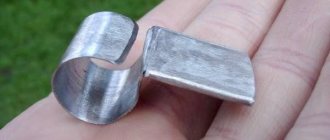Scales come in equal-arm, shoulder, lever and electronic scales. In order to make the first three types of scales, what you find at home is quite suitable: a clothes hanger, a ruler, a knitting needle from a broken umbrella, used lids and much more that, in principle, will not be useful to you. But the device of electronic scales is quite complex. In order to make electronic scales, you may need strain gauges, inductors, transformers and similar devices, which certainly don’t just lie around like trash.
Equal-armed home scales
Equal-arm homemade scales for measuring grams are similar to a swing; to perform them you need a level bar (ruler, knitting needle, level stick, etc.). “Cups” (small plastic bowls or bottle caps) are attached to the edges of the bar.
Three holes are punched in them at equal distances, into which a thread or fishing line is attached. A small strip is attached perpendicular to the center of the plank. It will play the role of an arrow that fixes the balancing of the shoulders. The scales are then secured to the stand and used effectively for their intended purpose.
Equal-arm scales, known to everyone from school, are made from a pencil, fixed with a heavy textbook on the edge of the table, and a ruler hanging on it in the form of a swing.
IMPORTANT!
The pencil should be positioned exactly in the center of the ruler. This is called determining the center of gravity.
An object of a certain weight is placed on one end of the ruler, and the load to be measured is placed on the other end. In this way, you can weigh oversized objects whose weight does not exceed 50 g. Due to the fact that there is a danger that the ruler will break. There is also a danger that it will turn over and the bulk materials under study will scatter.
Using the indicated principle, simple scales are made for larger and heavier objects. Instead of a ruler, use a board, and instead of a pencil, take, for example, a log.
Shoulder scales
These are unequal weight measuring devices, since the bowls in this case move along the bar. Such devices will help to measure not only the weight of any objects, but also measure any bulk products
IMPORTANT!
The bar for these scales is taken to be thin, and then it is more advisable to punch not a hole, but simply a groove.
Next, you need to install an arrow, for example from a needle or something similar, to record the deviation of the scales. The next step is to measure identical pieces in both directions from the center - the suspension point - and calibrate. It makes more sense to put notches there, since the bowls may slide off during the process of measuring weight.
IMPORTANT!
Bowls can also be bottle caps, plastic cups and bowls, but here they are not fixed to a rail, but hung on strings.
Lever scales
Method 1
You need to take a long straight stick, a ruler, no shorter than 30 - 35 cm. In this scheme, it plays the role of a rocker.
IMPORTANT!
The longer the rocker arm, the more accurate the results will be.
Next, you need to find the center on this “yoke”, measure equal segments on both sides of the marked center to install the bowls. Drill holes at these points. Secure a strong synthetic thread in the middle. Bottle caps or cut-off plastic cups are also suitable for bowls. Connect the threads from the bowls to the rail with a knot. Drill 3-4 holes along the upper perimeter of the cups at equal distances from each other, pass strong threads through them and tie them.
Make a scale arrow, you can cut out a cardboard triangle. Attach in the center of the rail where the main thread passes. Make sure that the stretched thread runs through the middle of the cardboard triangle. Hang the scales on a central thread on a support: a hook or a nail. Calibrate the scale.
IMPORTANT!
To ensure that the top of the triangle arrow in a suspended state clearly coincides with the stretched thread, you can stick a piece of plasticine to the bottom of a correspondingly lighter bowl.
Weights for such homemade scales can be found in a special store, either used as coins, or used the same tablets; their weight is indicated on the packages.
Method 2
Let's talk about another of the simplest lever scales. To do this, use a hanger hanging in any closet. Cups or bags are hung from both sides of clothes hangers. On one side, objects of known weight are placed in them. For example, factory-made packages with sugar and cereals are suitable; you can also take bottles filled with water.
Fabrication of the project design
We soldered all the components of the project using a perforated board. To connect the Arduino board and the HX711 module, we used female headers. We used jumper wires to connect the buttons and LEDs. After the soldering process was completed, we made sure that the voltage at the output of the LM7805 regulator was 5V. Finally, we added a power switch to the circuit. When everything was finished, the electronics part of our project looked like this:
How to make scales on the go
Many people have faced the need to measure the weight of something in nature. To solve this problem, you can make scales from plastic bottles. Identical vertical holes measuring 1 cm by 5 cm are cut in the sides of the bottle from the top closer to the neck. A stick or straw is inserted into them.
Either the object being weighed and a load of known mass, or two bottle caps are tied to its ends with strings. The object being measured is placed in one, and the counterweight in the other. It is logical that this device will allow you to weigh only light objects. But the principle itself is perfectly applicable in the case of large objects.
To do this, find a thick, strong stick, hang it by the middle to a strong knot or to a crossbar.
IMPORTANT!
The stick should hang very evenly.
An object to be weighed and a load of known mass are tied to it from different sides. Its role can again be played by bottles of water, unopened packages of cereals/salt/sugar. It is not difficult to measure the approximate mass in this way.
Homemade scales for fairly large items
You can also weigh objects up to 100 kg at home or on the go.
To complete them you will need:
- steelyard,
- two very strong bars 1.5 and 1 m long
- strong twine
- cargo hook
The design itself is presented in the diagram below.
According to the diagram, it is clear that the values of 10 and 100 cm were not chosen casually. The data from the steelyard will need to be increased 10 times. It is necessary to accurately position the hole on block 1. You can use a clamp (a) to hang the object. Moving the clamp with a known weight along bar 1, you should determine its correct location and secure it in this place with a nail. If you need scales for loads over 100 kg, then the bars for the structure need to be longer. But the second one is always 10 times larger than the first one (for example, 15 and 150 cm, then the load should supposedly weigh up to 150 kg), and the steelyard indicators are multiplied by the length of the first one (in the example, by 15, respectively).
BASIC | INTRODUCTION | THEORY | ASTROLOGY | MATERIALS | LABORATORY | PRACTICE | ARTICLESLever scales
Libra is a necessary tool in alchemical practice. Every alchemist should have them. You can simply buy them, or you can make them yourself. It’s not difficult, and working with a tool you’ve made yourself is much more interesting.
To make a simple lever scale, the following materials were required:
1 Two Soviet “plates” made of stainless steel. 2 Coated brass chain 2 meters. 3 Aluminum channel 1 meter. 4 Aluminum strip 1 meter. 5 Rope clamps 6 pieces. 6 Key rings 2 medium and 1 large. 7 Curtain rings (small) 6 pieces. 8 Lanyards, of which only 3 hooks are taken. 9 M4 nuts – 24 pieces 10 M5 screws 2 pieces and 8 M5 nuts 11 Thin-walled tube for bushings for hooks.
The scales are made from Soviet stainless steel plates purchased at a flea market. The wall thickness is 1 mm - this is not Chinese or Indian foil. It is convenient to work with such material, and the base for a small screw press has already been made from one of these plates. The chain is attached to the future scales using a clamp from a rope clamp and a curtain ring. This way:
How the fastenings are made. First, mark the collar of the plate with a caliper - it is divided into three equal parts. Then I used a drill to drill six holes for the clamps. After this, a plate with drilled holes is placed on top of the second plate and marks are made through the holes, along which holes are then drilled.
Easy to assemble. You need to disassemble the clamp, tighten the nuts to the end of the thread, and put the ring on the clamp. Insert the clamp into the holes on the plate and tighten two more nuts. The chain mount is ready. The chain is cut into equal parts, which are threaded into the rings on the bowls. The three chains are then connected at the top with a larger diameter key ring.
The balance beam is made of aluminum channel (sold in castoram). The length of the rocker arm is two bowls connected together. For structural rigidity, the rocker arm is made of two pieces of channel material folded together. The lower channel along the edges is sawn off at the corners.
Holes for attaching hooks are drilled along the edges of the channels. The hooks are taken from lanyards (sold at any hardware store). Fixed through a piece of tube as follows:
In the middle of the rocker, two holes are drilled for attaching a pointer and a clamp with a ring, made of an aluminum strip.
Everything is fitted in place and put together. The scales are ready.
Kettlebells
It remains to solve the problem of weights. There is no particular point in buying a set of weights. Accuracy on such scales, plus or minus a couple of grams, will not matter. These ones, made from washers, will also work.
After branding, a check on the scales showed that the weights were made quite accurately. All that remains is to paint them.
A set of eight (3 – 500g, 3 – 50g, 1 – 250g, 1 – 100g) weights is ready. For smaller coins it is easier to use coins selected by weight.
How to make your own electronic scales
Making electronic scales with your own hands is not the easiest task. First you need to carefully study the components and operating principle.
External components are:
- The weight processor is a separate block with a screen, keys, and microcircuits.
- A keyboard that should have working buttons “0” - “9”.
- Screen.
- Platform.
- A housing that hides all internal parts.
- Adjustable legs. For measurement accuracy, it is necessary to place the device level.
The measured load exerts pressure on it due to its gravity. Depending on the weight, the force of pressure of the measured object on the platform will change proportionally. Numerical values will be displayed on the screen.
The conversion of pressure data is facilitated by:
- Strain gauge
- Analog-to-digital converter ADC
- Microcontroller or processor.
Making scales with your own hands involves a careful study of each of the listed devices, their varieties, and a clear definition of what you need.
The heart of electronic scales can be considered a strain gauge. The strain gauge on which the strain gauge is based has a property that causes it to change resistance when deformed.
A voltage is sent to the strain gauge, and the output takes on a changed value, interacting with the strain gauge.
The analog-to-digital converter converts this voltage value into a digital code, which is then processed by the microcontroller. And the weight value is displayed on the screen. It happens in an instant.
There are several types of strain gauges:
- Single-point is built under the platform in the center. Used in trade, floor, packaging, technical and beam scales.
- Beam strain gauge. Intended, for example, for platform electronic scales.
- A rod strain gauge is required in particularly large scales - automobile, carriage, bunker. Used when weighing cargo from 20 tons.
- The S-shaped load cell is designed for overhead and crane scales.
- The double beam is used when weighing loads over 10,000 kg during transport weighing.
IMPORTANT!
When choosing strain gauges, take into account the further conditions of its use. For high-quality functioning, they must be reliably protected from moisture and dust. Also, before installing the strain gauge, carefully study the connection diagram. An undamaged, high-quality wire must run from the strain gauge to the analog-to-digital converter.
Connecting multiple strain gauges is extremely difficult. If you want this connection to be guaranteed to be of high quality, it is better to entrust this task to a professional.
The platform is made of stainless steel. Its service life is unlimited, which makes it possible to work with it in an aggressive environment without consequences. An organization specializing in rolled metal can help with the production of such a platform.
The housing for desktop electronic scales is made of plastic, while the housing for floor-standing, industrial scales is, of course, made of metal. A qualified welder can make a housing for industrial scales. The body needs to be painted to protect it from corrosion.
When producing homemade devices, the goal is always to save money, but when making electronic scales with your own hands, there is a risk of losing wasted money if you do not approach the process seriously and thoughtfully. The costs of the components are quite high. It is worth reading the instructions very carefully.
Required Components
For this project, we selected as simple and inexpensive components as possible, which can be purchased at any electronic components store.
- Arduino Nano board (buy on AliExpress).
- Weight/load sensor (Load cell) with a permissible load of up to 10 kg (buy on AliExpress).
- Amplifier module HX711 (buy on AliExpress).
- LCD display 16x2 with I2C interface module (buy on AliExpress).
- Resistor 1 kOhm – 2 pcs. (buy on AliExpress).
- LED – 2 pcs. (buy on AliExpress).
- Buzzer (buy on AliExpress).
- 7.4V battery (if you want to make the scale portable/portable) (buy on AliExpress).
- Voltage regulator LM7805 (buy on AliExpress).
The appearance of the components used in the project is shown in the following figure.











